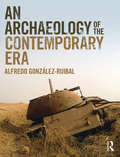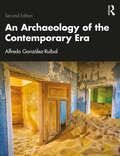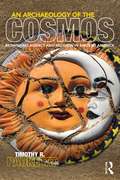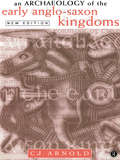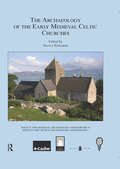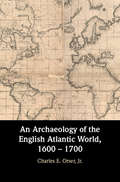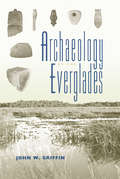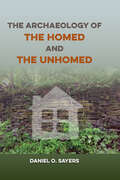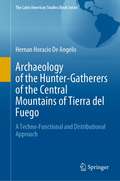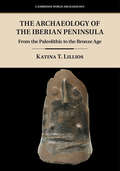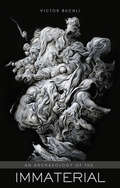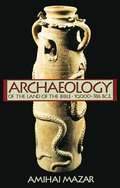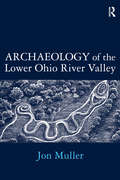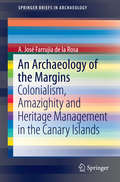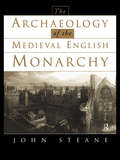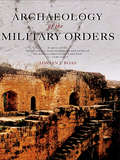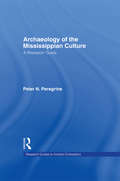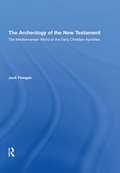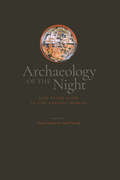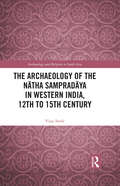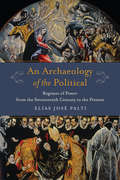- Table View
- List View
An Archaeology of the Contemporary Era: The Age of Destruction
by Alfredo Gonzalez-RuibalAn Archaeology of the Contemporary Era approaches the contemporary age, between the late nineteenth and twenty-first centuries, as an archaeological period defined by specific material processes. It reflects on the theory and practice of the archaeology of the contemporary past from epistemological, political, ethical and aesthetic viewpoints, and characterises the present based on archaeological traces from the spatial, temporal and material excesses that define it. The materiality of our era, the book argues, and particularly its ruins and rubbish, reveals something profound, original and disturbing about humanity. This is the first attempt at describing the contemporary era from an archaeological point of view. Global in scope, the book brings together case studies from every continent and considers sources from peripheral and rarely considered traditions, meanwhile engaging in an interdisciplinary dialogue with philosophy, anthropology, history and geography. An Archaeology of the Contemporary Era will be essential reading for students and practitioners of the archaeology of the contemporary past, historical archaeology and archaeological theory. It will also be of interest to anybody concerned with globalisation, modernity and the Anthropocene.
An Archaeology of the Contemporary Era
by Alfredo Gonzalez-RuibalThe second edition of An Archaeology of the Contemporary Era explores the period between the late nineteenth and twenty-first centuries and reflects on the archaeological theory and practice of the recent past.This book argues that the materiality of our times, and particularly its ruins and rubbish, reveals something profound and disturbing about modern societies. It examines the political, ethical, aesthetic, and epistemological foundations of contemporary archaeology and characterizes the excess of the contemporary period through its material traces. This book remains the first attempt at describing the contemporary era from an archaeological point of view. Global in scope, the book brings together case studies from every continent and considers sources from peripheral and rarely considered traditions, meanwhile engaging in interdisciplinary dialogue with philosophy, anthropology, history, and geography. This new edition includes the latest developments in the field, both methodological and theoretical, and adds new and exciting case studies to engage students. It also covers some of the most pressing issues of the present, as they are being addressed by archaeologists, such as pandemics, the antiracist movement, the global rise of reactionary populism, the ecological crisis, and climate change. An Archaeology of the Contemporary Era is essential reading for students and practitioners of the contemporary past, historical archaeology, and archaeological theory. It will also be of interest to anybody concerned with globalization, modernity, and the Anthropocene.
An Archaeology of the Cosmos: Rethinking Agency and Religion in Ancient America
by Timothy R. PauketatAn Archaeology of the Cosmos seeks answers to two fundamental questions of humanity and human history. The first question concerns that which some use as a defining element of humanity: religious beliefs. Why do so many people believe in supreme beings and holy spirits? The second question concerns changes in those beliefs. What causes beliefs to change? Using archaeological evidence gathered from ancient America, especially case material from the Great Plains and the pre-Columbian American Indian city of Cahokia, Timothy Pauketat explores the logical consequences of these two fundamental questions. Religious beliefs are not more resilient than other aspects of culture and society, and people are not the only causes of historical change. An Archaeology of the Cosmos examines the intimate association of agency and religion by studying how relationships between people, places, and things were bundled together and positioned in ways that constituted the fields of human experience. This rethinking theories of agency and religion provides readers with challenging and thought provoking conclusions that will lead them to reassess the way they approach the past.
An Archaeology of the Early Anglo-Saxon Kingdoms
by C. J. ArnoldAn Archaeology of the Early Anglo-Saxon Kingdoms is a volume which offers an unparalleled view of the archaeological remains of the period. Using the development of the kingdoms as a framework, this study closely examines the wealth of material evidence and analyzes its significance to our understanding of the society that created it. From our understanding of the migrations of the Germanic peoples into the British Isles, the subsequent patterns of settlement, land-use, trade, through to social hierarchy and cultural identity within the kingdoms, this fully revised edition illuminates one of the most obscure and misunderstood periods in European history.
The Archaeology of the Early Medieval Celtic Churches: No. 29 (The Society for Medieval Archaeology Monographs)
by Nancy EdwardsThis volume focuses on new research on the archaeology of the early medieval Celtic churches c AD 400-1100 in Wales, Ireland, Scotland, south-west Britain and Brittany. The 21 papers use a variety of approaches to explore and analyse the archaeological evidence for the origins and development of the Church in these areas. The results of a recent multi-disciplinary research project to identify the archaeology of the early medieval church in different regions of Wales are considered alongside other new research and the discoveries made in excavations in both Wales and beyond. The papers reveal not only aspects of the archaeology of ecclesiastical landscapes with their monasteries, churches and cemeteries, but also special graves, relics, craftworking and the economy enabling both comparisons and contrasts. They likewise engage with ongoing debates concerning interpretation: historiography and the concept of the Celtic Church, conversion to Christianity, Christianization of the landscape and the changing functions and inter-relationships of sites, the development of saints cults, sacred space and pilgrimage landscapes and the origins of the monastic town .
An Archaeology of the English Atlantic World, 1600 – 1700
by Charles E. Orser Jr.An Archaeology of the British Atlantic World is the first book to apply the methods of modern-world archaeology to the study of the seventeenth-century English colonial world. Charles E. Orser, Jr explores a range of material evidence of daily life collected from archaeological excavations throughout the Atlantic region, including England, Ireland, western Africa, Native North America, and the eastern United States. He considers the archaeological record together with primary texts by contemporary writers. Giving particular attention to housing, fortifications, delftware, and stoneware, Orser offers new interpretations for each type of artefact. His study demonstrates how the archaeological record expands our understanding of the Atlantic world at a critical moment of its expansion, as well as to the development of the modern, Western world.
Archaeology of the Everglades (Florida Museum of Natural History: Ripley P. Bullen Series)
by John W. Griffin Patricia C. Griffin"An important book about a natural World Heritage site that also has a rich human heritage."--American Archaeology "As the only available synthesis of the archaeology of the Everglades, this book fills an important niche."--Choice "Adds immeasurably to our knowledge of South Florida archaeology."--Journal of Field Archaeology "Offers a vivid glimpse into a rich cultural past in an oftentimes misunderstood and overlooked region of our country."--H-Net "Detailed descriptions of archaeological surveys and test excavations dovetail nicely with broader chapters on settlement, subsistence, and social organization. This is a valuable reference work."--SMRC Revista "An extremely important work. . . . John has brought his unprecedented knowledge of the archaeology together with his anthropological and ecological insights, to provide the most thorough synthesis of the predrainage aboriginal use of this area. Now that Congress has mandated the restoration of the Everglades . . . this book will provide researchers as well as the general public with an understanding of what the Everglades were like prior to drainage and how humans utilized this natural wonder."--Randolph J. Widmer, University of Houston Originally prepared as a report for the National Park Service in 1988, Griffin's work places the human occupation of the Everglades within the context of South Florida's unique natural environmental systems. He documents, for the first time, the little known but relatively extensive precolumbian occupation of the interior portion of the region and surveys the material culture of the Glades area. He also provides an account of the evolution of the region's climate and landscape and a history of previous archaeological research in the area and fuses ecological and material evidence into a discussion of the sequence and distribution of cultures, social organization, and lifeways of the Everglades inhabitants. Milanich and Miller have transformed Griffin's report into an accessible, comprehensive overview of Everglades archaeology for specialists and the general public. Management plans have been removed, maps redrawn, and updates added. The result is a synthesis of the archaeology of a region that is taking center stage as various state and federal agencies cooperate to restore the health of this important ecosystem, one of the nation's most renowned natural areas and one that has been designated a World Heritage Site and a Wetland of International Importance. This book will make a key work in Florida archaeology more readily available as a springboard for future research and will also, at last, allow John Griffin's contribution to south Florida archaeology to be more widely appreciated. John W. Griffin, a pioneer in Florida archaeology, was an archaeologist for both the Florida Park Service and the National Park Service (NPS), director of the NPS Southeast Archeological Center in Macon, Georgia, and director of the St. Augustine Preservation Board. Jerald T. Milanich is emeritus professor at the University of Florida/Florida Museum of Natural History and author of numerous books about the native peoples of the Southeast United States. James J. Miller was state archaeologist and chief of Florida’s Bureau of Archaeological Research for twenty years and is now a consultant in heritage planning. A volume in the Florida Museum of Natural History: Ripley P. Bullen Series
Archaeology of the High Plains
by James H. GunnersonThis publication presents an overview of the archaeology of the Central High Plains. The volume provides baseline information about the archaeology of the Bureau of Land Management's (BLM) Canon City [Colorado] District, the U.S.D.A. Forest Service's Regions II and III and the BLM's Albuquerque [New Mexico] District. This work describes the archaeology of portions of five states and represents a large geographic area ranging from the Continental Divide to the plains of Kansas and Nebraska.
The Archaeology of the Holy Land
by Jodi MagnessThis book provides an introduction to the archaeology and history of ancient Palestine - modern Israel, Jordan, and the Palestinian territories - from the destruction of Solomon's temple in 586 BCE to the Muslim conquest in 640 CE. Special attention is paid to the archaeology of Jerusalem and the Second Temple period, in the time of Herod the Great and Jesus. For each period, the book offers a historical background for the Mediterranean world and the ancient Near East, as well as the events in Palestine. Major sites such as Masada, Caesarea Maritima, and Petra are examined in archaeological and historical detail, along with the material culture - coins, pottery, glass, and stone vessels - of each period. This book provides a thorough overview of the archaeology of this historically vibrant part of the world.
The Archaeology of the Homed and the Unhomed (The American Experience in Archaeological Perspective)
by Daniel O. SayersThe first comprehensive discussion of the historical archaeology of homelessness In a time when the idea of home has become central to living the American dream, The Archaeology of the Homed and the Unhomed brings to the forefront the concept of homelessness. The book points out that homelessness remains underexplored in historical archaeology, a fact which may reflect societal biases and marginalization, and it provides the field’s first comprehensive discussion of the subject.Daniel Sayers argues that the unhomed and the home have been inherently interconnected in the real world across the past several centuries. Sayers builds a conceptual model that focuses on this dynamic and uses it to generate new insights into pre‒Civil War communities of Maroons and Indigenous Americans, Great Depression‒era hobo communities, and Midwest farmsteads. In doing so, he highlights the social complexities, ambiguities, and significance of the home and the unhomed in the archaeological record. Using a variety of data sources including documentary records and material culture and drawing on extensive fieldwork, Sayers illuminates how homelessness is created, reproduced, and disparaged by the dominant culture. The book also emphasizes the importance of applied archaeology. Through these studies, Sayers contends that activist archaeologists have a role—and responsibility—to share their knowledge to help policy makers and stakeholders understand the unhomed, homelessness, and the American experience in this area. A volume in the series the American Experience in Archaeological Perspective, edited by Michael S. Nassaney and Krysta Ryzewski
Archaeology of the Hunter-Gatherers of the Central Mountains of Tierra del Fuego: A Techno-Functional and Distributional Approach (The Latin American Studies Book Series)
by Hernan Horacio De AngelisThis work book contributes to the knowledge about human settlements in the Isla Grande of Tierra Del Fuego by the hunter-gatherer societies that inhabited the area until the early twentieth century. The central theme is the study of technological organization as an approach to the management strategies of biotic and abiotic resources, as well as the occupation of space, considering the different environments represented in the area and the differential supply of resources. As a general framework, the book proposes instrumental methodologies that allow us to look at the characterization of the social and economic organization of hunter-gatherer societies from the point of view of the analysis of natural resources management, the resources introduced by Europeans and the spatial organization of technical activities.
The Archaeology of the Iberian Peninsula: From the Paleolithic to the Bronze Age (Cambridge World Archaeology)
by Katina T. LilliosIn this book, Katina Lillios provides an up-to-date synthesis of the rich histories of the peoples who lived on the Iberian Peninsula between 1,400,000 (the Paleolithic) and 3,500 years ago (the Bronze Age) as revealed in their art, burials, tools, and monuments. She highlights the exciting new discoveries on the Peninsula, including the evidence for some of the earliest hominins in Europe, Neanderthal art, interbreeding between Neanderthals and modern humans, and relationships to peoples living in North Africa, the Mediterranean, and Western Europe. This is the first book to relate the ancient history of the Peninsula to broader debates in anthropology and archaeology. Amply illustrated and written in an accessible style, it will be of interest to archaeologists and students of prehistoric Spain and Portugal.
An Archaeology of the Immaterial
by Victor BuchliAn Archaeology of the Immaterial examines a highly significant but poorly understood aspect of material culture studies: the active rejection of the material world. Buchli argues that this is evident in a number of cultural projects, including anti-consumerism and asceticism, as well as other attempts to transcend material circumstances. Exploring the cultural work which can be achieved when the material is rejected, and the social effects of these ‘dematerialisations’, this book situates the way some people disengage from the world as a specific kind of physical engagement which has profound implications for our understanding of personhood and materiality. Using case studies which range widely in time over Western societies and the technologies of materialising the immaterial, from icons to the scanning tunnelling microscope and 3-D printing, Buchli addresses the significance of immateriality for our own economics, cultural perceptions, and emerging forms of social inclusion and exclusion. An Archaeology of the Immaterial is thus an important and innovative contribution to material cultural studies which demonstrates that the making of the immaterial is, like the making of the material, a profoundly powerful operation which works to exert social control and delineate the borders of the imaginable and the enfranchised.
Archaeology of the Land of the Bible
by Amihai MazarNotes to Reader: I did not read this carefully to correct. I did format the table of contents so it would be readable; put in page breaks, making sure that no first or last lines of the page were missing and that they followed as they should; scanned and put in missing pages and deleted duplicated pages; described some of the illustrations ( descriptions in brackets are mine). I had the spell-check on as I went, so where I found errors I corrected them but actually it was a very good scan. I did nothing with the indices or end-of-chapter notes. I think they're readable as they are-the scanner seems to have validated them--but if anyone reading this book needs anything fixed let me know and I'll get the book. Whoeveer scanned and submitted this book did an excellent job. Cindy-popularplace@yahoo.com
Archaeology of the Lower Ohio River Valley: New World Archaeological Record (New World Archaeological Record Ser.)
by Jon MullerAlthough it has been occupied for as long and possesses a mound-building tradition of considerable scale and interest, Muller contends that the archaeology of the lower Ohio River Valley--from the confluence with the Mississippi to the falls at Louisville, Kentucky - remains less well-known that that of the elaborate mound-building cultures of the upper valley. This study provides a synthesis of archaeological work done in the region, emphasizing population growth and adaptation within an ecological framework in an attempt to explain the area's cultural evolution.
An Archaeology of the Margins: Colonialism, Amazighity and Heritage Management in the Canary Islands (SpringerBriefs in Archaeology)
by A. José Farrujia de la RosaThis book analyses the problematics of archaeological heritage management in the Canary Islands, which are echoed in other parts of the world where the indigenous heritage is under-represented. The present-day management of Canarian archaeological heritage has a very specific and unusual context given that the archipelago is located on the fringes of Europe, belonging to Spain and therefore to the European Unión, but geographically and in terms of early history being part of Africa. From a theoretical perspective, then, the proposed book analyzes issues such as the effects of colonialism and eurocentrism on the management of the archaeological heritage. It also examines the evolutionist and historico-cultural models used to analyze past societies and, ultimately, used to create identities that influence archaeological heritage management itself. From a practical point of view, the book presents a proposal for enhancing the archaeological heritage of the Canary Islands through the creation of archaeological parks (providing some concrete examples in the case of the city of La Laguna) and the active involvement of the local community. Parallel to this, the book considers the Canarian Archipelago as part of a problematic that is not unique to this area but is an example of poor indigenous heritage management overall. It demonstrates how the course of history and the politics of the past still have an excessive influence on the way in which the present-day archaeological heritage is interpreted and managed. Therefore, this book provides an almost unique opportunity for uncovering the history of archaeology within the margins of Europe (in fact, in an African region) and exploring colonial and foreign influences. In many ways it is a mirror of archaeological mainstreams and an exercise in (re)thinking the aim and status of present-day archaeology.
The Archaeology of the Medieval English Monarchy
by John SteaneThe Archaeology of the Medieval English Monarchy looks at the period between the reign of William the Conqueror and that of Henry VIII, bringing together physical evidence for the kings and their courts. John Steane looks at the symbols of power and regalia including crowns, seals and thrones. He considers Royal patronage, architecture and ideas on burials and tombs to unravel the details of their daily lives supported with many illustrations.
The Archaeology of the Mediterranean Iron Age: A Globalising World c.1100–600 BCE
by Tamar HodosThe Mediterranean's Iron Age period was one of its most dynamic eras. Stimulated by the movement of individuals and groups on an unprecedented scale, the first half of the first millennium BCE witnesses the development of Mediterranean-wide practices, including related writing systems, common features of urbanism, and shared artistic styles and techniques, alongside the evolution of wide-scale trade. Together, these created an engaged, interlinked and interactive Mediterranean. We can recognise this as the Mediterranean's first truly globalising era. This volume introduces students and scholars to contemporary evidence and theories surrounding the Mediterranean from the eleventh century until the end of the seventh century BCE to enable an integrated understanding of the multicultural and socially complex nature of this incredibly vibrant period.
Archaeology of the Military Orders: A Survey of the Urban Centres, Rural Settlements and Castles of the Military Orders in the Latin East (c.1120-1291)
by Adrian BoasFirst Published in 2004. Routledge is an imprint of Taylor & Francis, an informa company.
Archaeology of the Mississippian Culture: A Research Guide (Peoples of the Ancient World)
by Peter N. PeregrineFirst published in 1996. Routledge is an imprint of Taylor & Francis, an informa company.
The Archaeology Of The New Testament: The Mediterranean World Of The Early Christian Apostles (Princeton Legacy Library #154)
by Jack FineganThe Archeology of the New Testament is the authoritative illustrated account of what is presently known about the chief sites and monuments connected with the life of Jesus and the history of the early church. To follow the order of the New Testament, it first investigates sites connected with John the Baptist and then proceeds to Bethlehem and
Archaeology of the Night: Life After Dark in the Ancient World
by Nancy Gonlin & April NowellHow did ancient peoples experience, view, and portray the night? What was it like to live in the past when total nocturnal darkness was the norm? Archaeology of the Night explores the archaeology, anthropology, mythology, iconography, and epigraphy of nocturnal practices and questions the dominant models of daily ancient life. A diverse team of experienced scholars uses a variety of methods and resources to reconstruct how ancient peoples navigated the night and what their associated daily—and nightly—practices were. This collection challenges modern ideas and misconceptions regarding the night and what darkness and night symbolized in the ancient world, and it highlights the inherent research bias in favor of “daytime” archaeology. Numerous case studies from around the world (including Oman, Mesoamerica, Scandinavia, Rome, Great Zimbabwe, Indus Valley, Peru, and Cahokia) illuminate subversive, social, ritual, domestic, and work activities, such as witchcraft, ceremonies, feasting, sleeping, nocturnal agriculture, and much more. Were there artifacts particularly associated with the night? Authors investigate individuals and groups (both real and mythological) who share a special connection to nighttime life. Reconsidering the archaeological record, Archaeology of the Night views sites, artifacts, features, and cultures from a unique perspective. This book is relevant to anthropologists and archaeologists and also to scholars of human geography, history, astronomy, sensory studies, human biology, folklore, and mythology. Contributors: Susan Alt, Anthony F. Aveni, Jane Eva Baxter, Shadreck Chirikure, Minette Church, Jeremy D. Coltman, Margaret Conkey, Tom Dillehay, Christine C. Dixon, Zenobie Garrett, Nancy Gonlin, Kathryn Kamp, Erin Halstad McGuire, Abigail Joy Moffett, Jerry D. Moore, Smiti Nathan, April Nowell, Scott C. Smith, Glenn R. Storey, Meghan Strong, Cynthia Van Gilder, Alexei Vranich, John C. Whittaker, Rita Wright
The Archaeology of the North American Great Plains (Cambridge World Archaeology)
by Douglas B. BamforthIn this volume, Douglas B. Bamforth offers an archaeological overview of the Great Plains, the vast, open grassland bordered by forests and mountain ranges situated in the heart of North America. Synthesizing a century of scholarship and new archaeological evidence, he focuses on changes in resource use, continental trade connections, social formations, and warfare over a period of 15,000 years. Bamforth investigates how foragers harvested the grasslands more intensively over time, ultimately turning to maize farming, and examines the persistence of industrial mobile bison hunters in much of the region as farmers lived in communities ranging from hamlets to towns with thousands of occupants. He also explores how social groups formed and changed, migrations of peoples in and out of the Plains, and the conflicts that occurred over time and space. Significantly, Bamforth's volume demonstrates how archaeology can be used as the basis for telling long-term, problem-oriented human history.
The Archaeology of the Nātha Sampradāya in Western India, 12th to 15th Century (Archaeology and Religion in South Asia)
by Vijay SardeThis book studies Nātha sampradāya through archaeological evidence for the first time. Drawing on a pioneering approach to the study of ascetic traditions, it investigates not only the nature of the Nātha sampradāya’s religious architecture but also examines the extent to which they shared space with other religious groups such as the devotees of Siva and Sakti, Buddhism, and Islam, especially with the Sufi tradition. Focusing on western India, the book sifts through a variety of archaeological evidence and documentation of their temples, caves, and maṭhas. It critically analyses iconographic representations of ascetics on temple walls and sculptural representations of yogic postures or āsanas. Further, these representations are discussed within a pan-South Asian framework to highlight both the commonalities of the tradition across the subcontinent and the regional specificities, along with their chronological spread. Breaking new ground, this volume will be of great interest to scholars and researchers of religion, especially Hinduism, history, archaeology, and South Asian studies.
An Archaeology of the Political: Regimes of Power from the Seventeenth Century to the Present (Columbia Studies in Political Thought / Political History)
by Elías PaltiIn the past few decades, much political-philosophical reflection has been dedicated to the realm of "the political." Many of the key figures in contemporary political theory—Jacques Rancière, Alain Badiou, Reinhart Koselleck, Giorgio Agamben, Ernesto Laclau, and Slavoj i ek, among others—have dedicated themselves to explaining power relations, but in many cases they take the concept of the political for granted, as if it were a given, an eternal essence.In An Archaeology of the Political, Elías José Palti argues that the dimension of reality known as the political is not a natural, transhistorical entity. Instead, he claims that the horizon of the political arose in the context of a series of changes that affirmed the power of absolute monarchies in seventeenth-century Europe and was successively reconfigured from this period up to the present. Palti traces this series of redefinitions accompanying alterations in regimes of power, thus describing a genealogy of the concept of the political. Perhaps most important, An Archaeology of the Political brings to theoretical discussions a sound historical perspective, illuminating the complex influences of both theology and secularization on our understanding of the political in the contemporary world.
